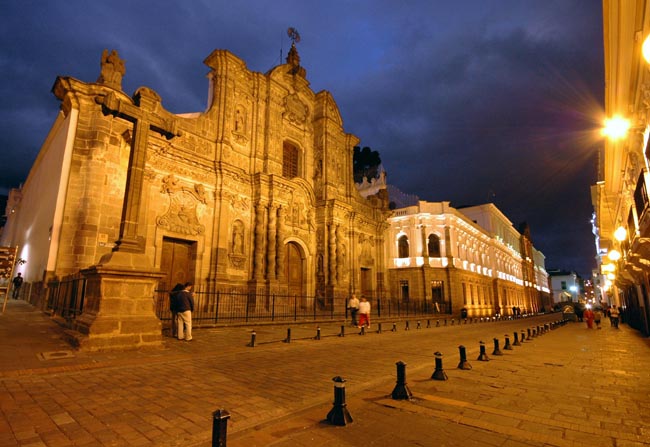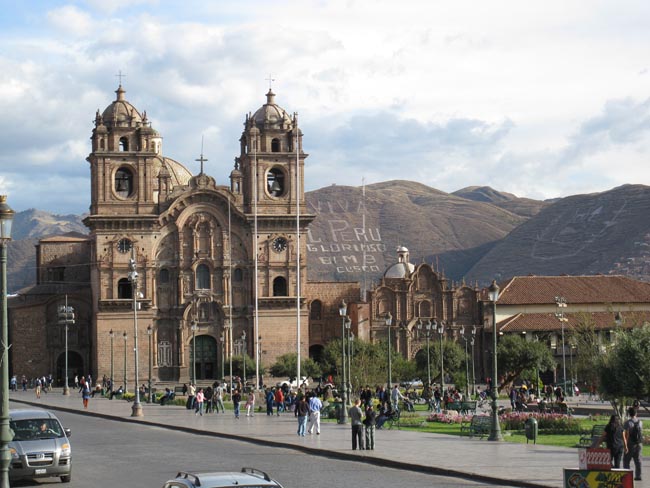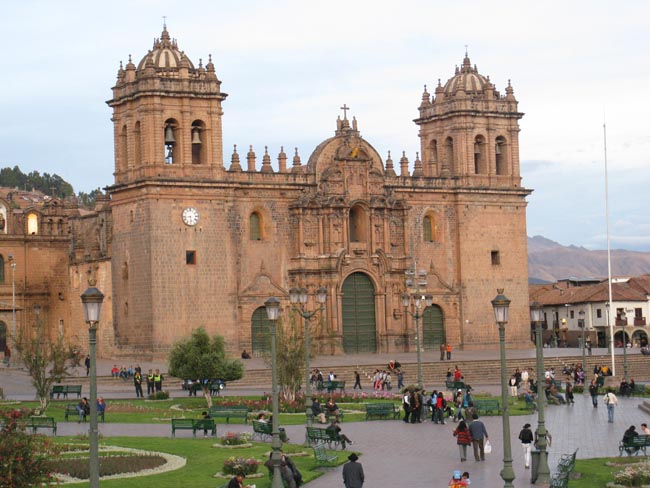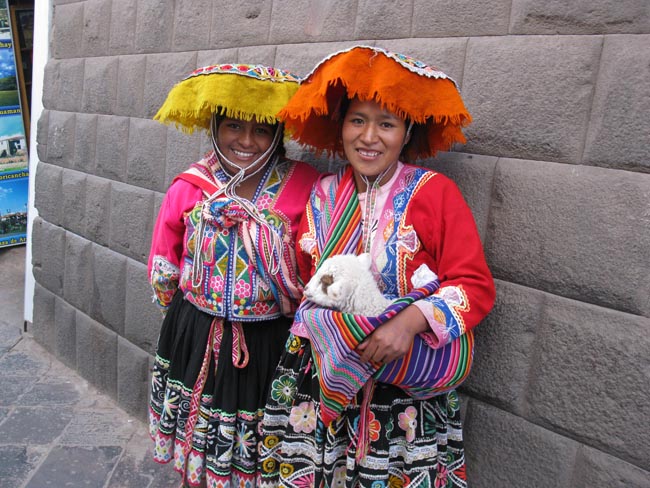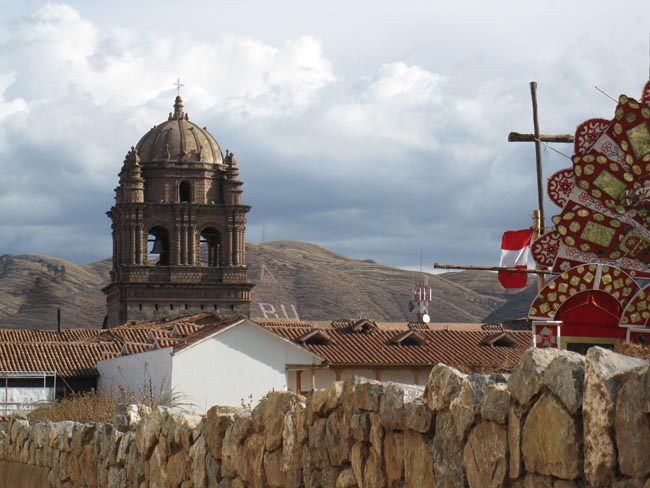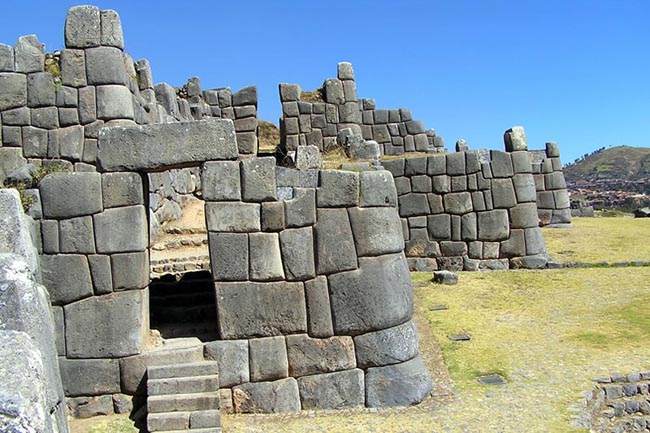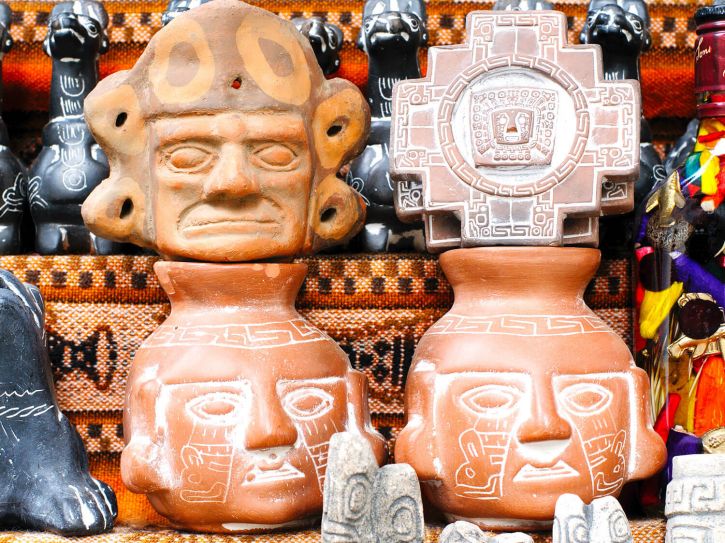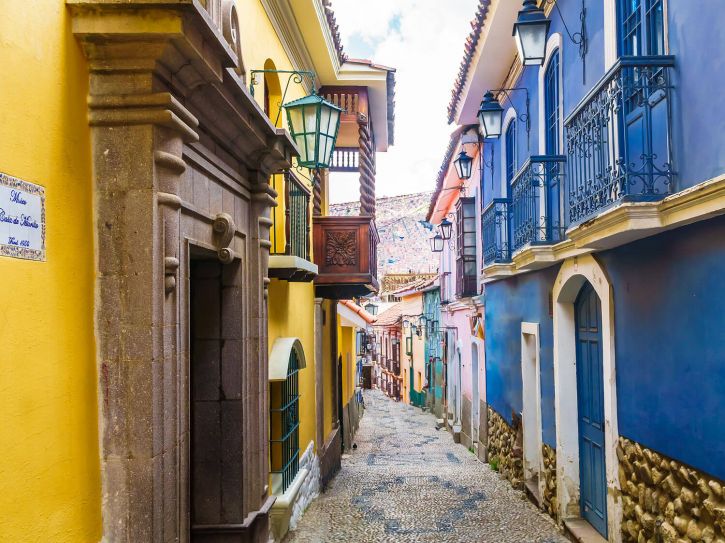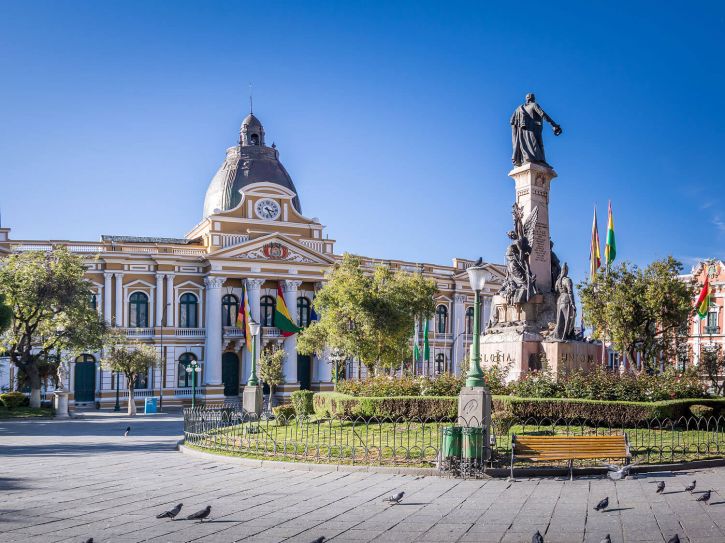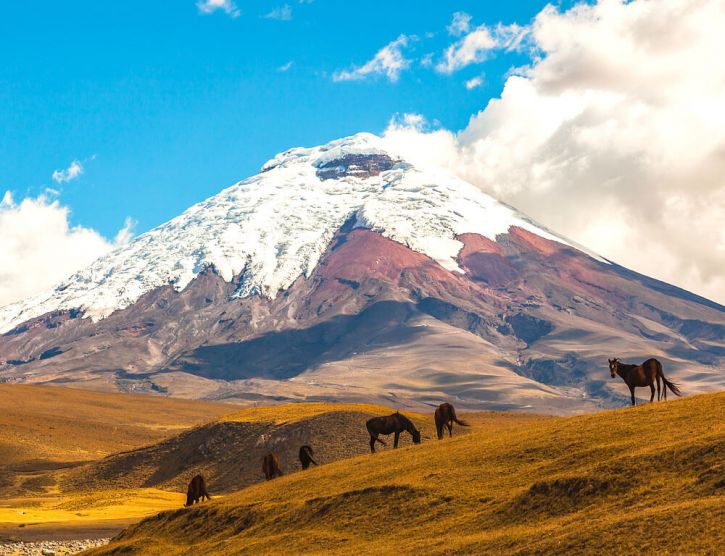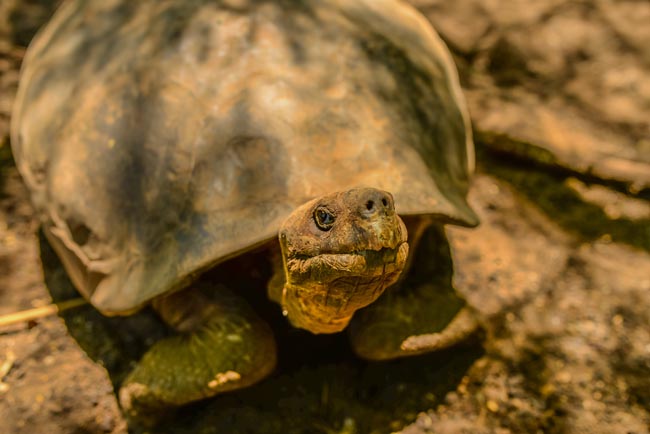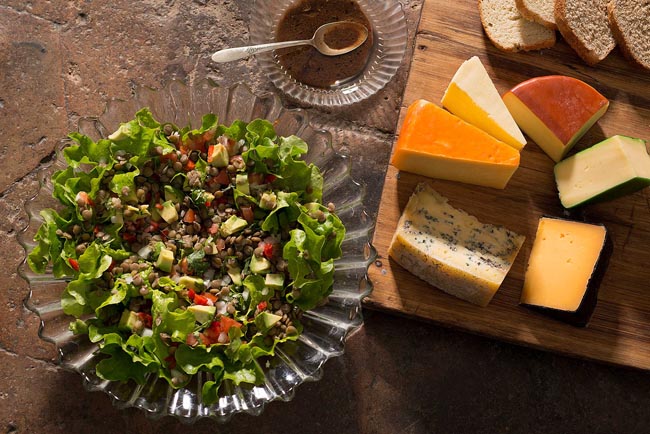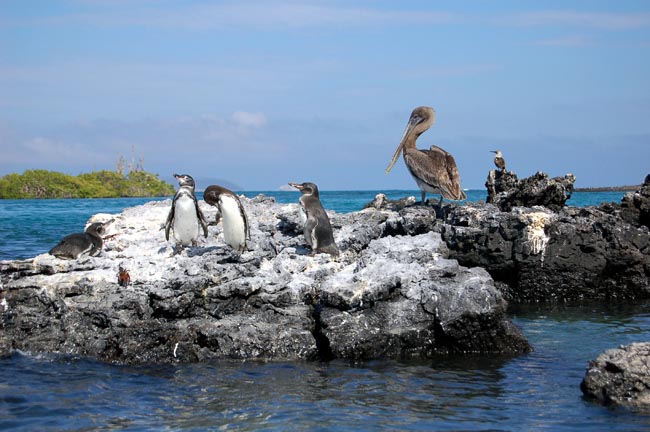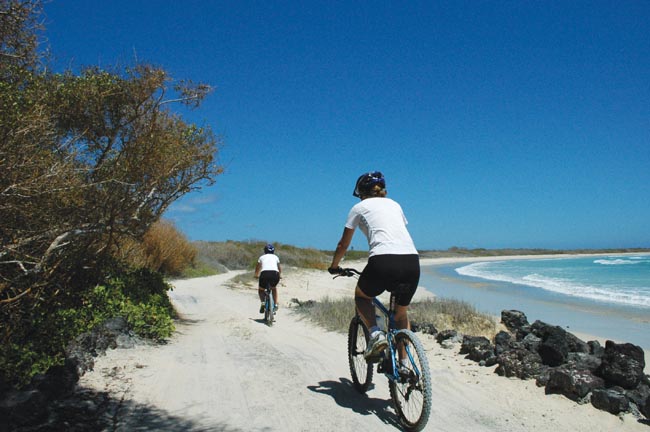Nestled in the shadows of the Pichincha volcano high in the Andes, Ecuador's capital city, Quito, boasts a wealth of attraction and a natural environment that can be described as nothing short of stunning.
It is here that we begin our mammoth 32-day trek through South America on this Ecuador, Peru & Bolivia tour.
The initial week of this outstanding tour is spent strolling alongside centuries-old architecture of palaces and churches in the World Heritage-designated colonial urban centres of Quito.
We follow the 'Avenue of the Volcanoes' past snow-capped summits and mystical rivers amid the Cordillera Mountains, relaxing in quaint villages that enjoy worldwide fame for their spirit-replenishing hot springs, and perusing the stalls of traditional markets alive with drifting melodies of Andean pipe music and Quichua; the native language derived from the Incan tongue.
A boat trip on transparent waters around the naturalist wonderlands of the Galapagos Islands truly is a once-in-a-lifetime experience and periodic dockings ensure we get up-close and personal with a diversity of flora and fauna that no destination in the world can rival.
Penguins, tortoises, sea lions and iguanas are but a few species of the massive range of wildlife that we encounter as we discover why this special destination, which has changed little since the days of Darwin, remains one of the most popular destinations in the world.
Flying into Lima, Peru, we tour the many sights of what was one of the most important cities in South America during the Spanish colonial era.
From its underground catacombs and intricately carved churches, to its recently-restored plazas, ornate facades and wooden balconies, Lima evinces an atmosphere of former glory at every turn and with about one-third of the population taking up residence in the capital, it gives travellers valuable insights into contemporary Peruvian culture and society.
Along the Urubamba Valley, we find one of the most scenic routes in the country and exploring the temple and pyramid ruins of the 'Lost City of the Incas' at Machu Picchu is to appreciate fully the architectural, engineering and design genius of one of the most influential and mysterious civilizations in the history of the Americas.
Through mud-brick villages with colourful local markets on the Andean Plains, we make headway for Bolivia, stopping often en route to take in historic and cultural attractions found off the beaten path.
Bolivia is an out-of-the-way destination like no other, a feature that allows us to enjoy a country very much in its natural state; its long isolation has meant that Bolivian lifestyles, traditions and the country's natural environment have been wholly preserved over the years.
It is a land wherein women still wear multi-coloured petticoats and rural locals still weave ponchos, like their ancestors did, and is entirely unspoiled by the influence of mass tourism; its rough edges only adding to the sense of adventure.
Prices below are per person, twin-sharing costs in US Dollars (USD). Pricing does not include airfare to/from the tour and any applicable taxes. For single supplement rates and taxes (if any), please refer to below Prices & Dates table. For general information on flights to/from the tour, click here.
Your Travel and Accommodation Arranged For You
Tips Included for Driver, Restaurant Staff, Local Guides
Authentic Local Experiences With Lots Of Inclusions.
Select a date below to reserve your spot:
The above prices are subject to an additional $195 for taxes/fees levied on flights that occur as part of the tour. The internal airfares ARE included (any exceptions are listed in red below), but we list the taxes separately on your invoice as they are beyond our control and can change at any time.
$1500 per person deposit required due to the nature of internal flights and Galapagos cruise deposit policies. Contrary to our usual terms governing deposits, once the tour becomes 'guaranteed' your deposit becomes 100% non-refundable/non-transferable.
Optional Single Supplement: $3320 USD (number of singles limited).
This tour may require a mandatory single supplement charge of $3320 if you join our share program and we are unable to pair you.
Download Itinerary
Day 1 Arrival in Quito
Arrive in Quito and transfer to our hotel. Welcome to Ecuador!
Quito (2788 m/9,200 feet) is Ecuador's lovely capital city, nestled against Pichincha Volcano high in the Andes.
Overnight in Quito.
Included Meal(s): Dinner
Day 2 Quito: City Tour
Today we tour old Spanish Colonial Quito, preserved by UNESCO as a World Heritage Site.
As we enter the streets of Old Quito we step into the past, surrounded by centuries-old architecture. We stop at the commanding Legislative Palace, whose murals record Ecuador's history. We will see Quito's most beautiful religious buildings, including the cathedral, the Independence Plaza, San Francisco Church, and visit one of Quito's most impressive religious
buildings, La Compania church, whose ornate facade and solid gold altars make it one of the most famous of South American churches. We visit the famous Panecillo Hill with its towering winged statue of the Virgin of the Apocalypse with views of north and south of Quito and the surrounding mountains.
This afternoon we travel 22 km (14 miles) north of Quito to the Equator line monument, known as the "middle of the world," where you can stand with one foot in the Northern and the other in the Southern Hemisphere. We also visit the excellent on-site ethnographic museum with exhibits pertaining to the many indigenous peoples of Ecuador.
Overnight in Quito.
Included Meal(s): Breakfast and Dinner
Not finding what you're looking for?
Our specialists can take away the stress and create a private custom tour tailored to your exact interests and budget.
Day 3 Quito - Otavalo Valley - Ibarra
Today we journey north to the Otavalo Valley region.
In early years the Otavalo Valley was filled with farmers who raised crops in fertile lands where they lived. In the 14th century the Inca expansion reached north into the Otavalo area. The Caraquis who inhabited the area resisted the invaders. For 17 long years fierce fighting continued as the defiant Caraquis refused to be subjugated by the Incas. The Spanish arrived a few years after the Incas. They established a Hacienda system of workshops where
Otavalenos were forced to work 15 hour days weaving fabrics.
Today this weaving tradition forms the basis of a lucrative industry that has allowed the Otavaleno indigenous peoples to join the world economy while retaining their traditional values and skills. During our time in the valley we will have a chance to visit with the local Otavalenos and see them working their craft. We visit a traditional home with adobe walls and visit with the owners who raise guinea pigs, a local delicacy. In Otavalo city, we'll have a
chance to wander through the colourful handicraft stalls.
Our hosteria is located nearby the colonial town of Ibarra (2121 m/7,000 feet), known as the "White City" since many of it houses are colonial style, red-tiled and whitewashed.
Overnight in Ibarra.
Included Meal(s): Breakfast and Dinner
Day 4 Ibarra - Avenue of Volcanoes & Cotopaxi - La Cienega
Today we follow in the footsteps of the German scientist, Alexander von Humboldt, and rediscover what in 1802 he called the "Avenue of Volcanoes," a 325 km (202 mi) long valley between the major cordillera ranges. Massive and standing alone, the volcanoes provide brooding, snow-covered contrast to the green equatorial lushness. We see snow-capped summits, mystical brooks and rivers, terraced farmlands, small villages and fascinating cultures.
We’ll take the Pan-American Highway southwards and take a side road to discover the impressive volcanism, flora, and bird-life that the Cotopaxi national park protects. Whilst in the national park, we will visit to the Interpretation Center and the Limpiopungo Lake and also complete a short hike that will let us enjoy this natural wonder.
The area is also home to a number of exceptional haciendas, some of which date back to the 16th century. La Cienega Hacienda is located near the village of Lasso near the foot of Cotopaxi and has been witness to centuries of important events in the history of Ecuador.
Overnight at Hosteria La Cienega (Lasso area).
Included Meal(s): Breakfast and Dinner
Day 5 La Cienega - Pillaro - Banos
Today we continue our journey to Banos. We will make a stop in Pillaro where we will visit a traditional workshop of masks that are used in the Pillaro Devil parade, an important cultural expression of the local indigenous people.
We arrive in Banos, a small town whose elevation gives it an extremely agreeable climate and the surrounding mountainsides are brilliant green against the white summit of the Volcano Tungurahua. The word Banos means "baths" and, as the name indicates, the highlight is the numerous hot spring baths in the area. Today we have opportunity to visit the hot springs as well as wander the streets and market of this picturesque town. You can also hike into the nearby hillsides, along farmers' donkey trails through fields of corn, passion-fruit, and various other local products. A must-see is the Basilica dedicated to the Virgin of the Holy Water, credited with performing many miracles in the Banos area.
Overnight in Banos.
Included Meal(s): Breakfast and Dinner
Day 6 Banos - Devil's Bowl - Riobamba
Before departing Banos, we'll have a short walk to view one of the most impressive waterfalls in South America, the Devil's Bowl. At El Manto de la Novia we can experience a cable car ride over the Pastaza River Canyon.
After lunch we'll travel through open farmland flowing over the high ridges of the Western Andes to Riobamba (2750m/9,035 ft).
Riobamba is a small, charming Andean city with colonial architecture, cobble-stone streets, impressive plazas, and a fascinating market. The Monasterio de las Conceptas, Parq The very heart of Riobamba has a small-town feel, and the feeling is even intensified by a large number of indigenous people strolling around Riobamba dressed in their traditional clothes.
Overnight in Riobamba.
Included Meal(s): Breakfast and Dinner
Day 7 Riobamba - Ingapirca - Cuenca
Today our journey continues by road to Cuenca, detouring to visit the Archaeological Complex of Ingapirca, the best-preserved and most important Inca site in Ecuador. Though not on the same scale as, say, Machu Picchu, the ruins include a large oval construction once used for ritual and astronomical purposes. Just outside the ruins, the Museo Sitio de Ingapirca displays a skeleton, tools, and other artifacts recovered from the area. We'll also visit a local market, see the first church established in Ecuador, tour the historic town of Alausi, and enjoy views of Devils Nose Mountain.
Once the site of an Inca settlement, Cuenca today is considered Ecuador's most beautiful city. Its historical connection with Spain is marked by narrow cobblestone streets, quaint parks, and romantic plazas. Charming adobe houses, wrought iron balconies, and religious art treasures capture the spirit of centuries long past. Cuenca, almost hidden away in a southern valley, was isolated until recent times; it wasn't until 1960 that paved roads were built to Quito and Guayaquil. Today's Cuenca is surrounded by small villages whose citizens create intricately detailed jewelry, beautiful ceramics, and masterfully-designed hand-woven shawls.
You'll have time to wander the quaint streets in the compact centre of this charming town before reconvening for our evening meal.
Overnight in Cuenca.
Included Meal(s): Breakfast and Dinner
Day 8 Cuenca: Walking Tour & Museo del Banco Central
This morning we have a leisurely walking tour of Cuenca along the main plaza, Parque Calderon, and enter the old Cathedral, renovated for the visit of Pope John Paul in 1985. We also see the Monastery of El Carmen and visit La Inmaculada Concepcion while strolling the cobbled streets.
This afternoon we visit the Museo del Banco Central, which contains a permanent collection of black and white photos of 19th and early 20th century Cuenca, as well as displays of art and archaeological pieces, and ethnographic dioramas.
We also visit a Panama hat factory. In 1835 Manuel Alfaro, a Spanish entrepreneur, arrived in the port of Guayaquil in the province of Guayas. He settled in nearby Montecristi and quickly realized the economic potential of the toquilla hat, setting up his own chain of production from the straw plantations to circuits of weavers. His hats were soon being exported from the ports of Guayaquil and Manta to Panama, which was quickly becoming an important centre and staging post for international trade and travel. Here Alfaro opened a commercial centre selling his hats, cacao and pearls, thus beginning the association of the Ecuadorian toquilla hat with Panama.
Overnight in Cuenca.
Included Meal(s): Breakfast and Dinner
Day 9 Cuenca: At Leisure
Today is yours to explore and experience this charming town on your own.
This city, a UNESCO World Heritage Site, has once been named the best city in which to retire by Travel and Leisure magazine; indeed, these days more than 8,000 US and Canadian citizens make Cuenca their home.
Overnight in Cuenca (due to the informal nature of the day, and for a break from the group meal dynamic, we don't include your evening meal today).
Included Meal(s): Breakfast
Day 10 Cuenca - Cajas National Park - Guayaquil
Today we travel by road to Guayaquil via Cajas National Park.
The park contains hundreds of clear, cold lakes, streams, and rivers. Weather-permitting (which can be highly changeable at this altitude), the park can provide an excellent opportunity for us to hike the grassland of Paramo Region or visit a forest of polelypsis trees, the highest altitude tree in the world. Recently the park's management introduced llamas and alpacas as part of a breeding program to re-introduce these animals to the southern highlands. Keep your eyes peeled for the many bird species that make the park their home, especially for the silhouette of a soaring (and extremely rare) Andean Condor, which can sometimes be spotted here riding the thermal up-drafts.
We continue to the coast with a stop at a cocoa plantation to learn about its cultivation and the production of Ecuadorian chocolate.
Our destination is the main port city of Ecuador, known as a gateway to Pacific beaches and the Galapagos Islands. Stretching along the Guayas River is the waterfront Simón Bolívar promenade, home to La Rotonda monument.
Overnight in Guayaquil.
Included Meal(s): Breakfast and Dinner
Day 11 Guayaquil - Fly to the Galapagos / San Cristobal Airport
Today you will say farewell to your Tour Leader and depart from Guayaquil to San Cristobal on a 2-hour flight. Upon arrival, passengers are picked up at the airport by our naturalist guides and taken on a ten-minute bus drive to the pier to board the M/V Galapagos Legend.
An archipelago of 12 large and several hundred smaller volcanic islands occupying a 4800 sq km (3,000 sq mile) area about 1000 km (620 miles) west of Ecuador, the Galapagos Islands have become one of the world's premier adventure travel destinations. Over the course of your visit, you'll enjoy up-close views of unusual, specially-adapted animals, plants and terrains including sea lions, tortoises, iguanas, land and sea birds, volcanic landscapes, unusual cacti and vegetation. Little has changed about the islands since Charles Darwin's visit in 1835 to "this little world within itself" inspired his first theories of evolution. Nearly the entire archipelago is a natural sanctuary where you'll have thrilling encounters with some of the world's last completely untamed wildlife that has never learned to fear the presence of humans.
We will be navigating the Galapagos on board the M/V Galapagos Legend, a 110-passenger luxury expedition ship totally converted in 2001 and recently renovated. The M/V Galapagos Legend has all-new passenger accommodations with 1800 sq m of social areas and was built with marine certified materials qualifying with Safety of Life at Sea specifications. All cabins are booked in "outside" Junior Suite cabins with plenty of space for luggage in the wardrobe closet. Private bathrooms feature hot and cold water, shower, and a hair dryer. Also aboard, a highly-trained crew, 24 hour physician, and naturalist multilingual guides. An auditorium for conferences, spacious social areas, dining room, 24 hour coffee bar, swimming pool and sun decks, observation platforms, cocktail bars, long distance calls, fully air-conditioned.
AFTERNOON - Interpretation Center & Tijeretas Hill (San Cristobal Island)
Dry landing (no need to step into water upon landing). The interpretation center is full of interesting information and offers the perfect overview to the formation of Galapagos, its significance in the world, threats and conservation efforts. Followed by a hike to Frigatebird Hill (Cerro Tijeretas) we will have great looks at both species of frigatebird, with the bonus of a beautiful view of the bay below.
Difficulty level: easy /moderate
Type of terrain: flat/stairs/rocky
Duration: 1-hour visit/1-hour walk
Return to ship for passenger welcome and briefing; there is a presentation of the crew. At this time a safety drill is practiced. Free time on board. After dinner a guide's briefing on next day activities in the auditorium.
* The cruise portion of this itinerary has been provided provided by the cruise operator and should be taken as guidance only. Last minute operation considerations and national park policies can result in alterations and deviations from this schedule, sometimes at late notice. Such changes are the prerogative of the cruise operator over which Adventures Abroad has no control.
Overnight Galapagos Cruise.
Included Meal(s): Breakfast, Lunch and Dinner
Day 12 Galapagos Cruise / Gardner Bay, Gardner & Osborn Islets (Española Island)
Wet landing (you will have to step into shallow water and walk to shore - see your pre-trip notes for suggestions re footwear). One of the most stunning beaches in all of Galapagos, the long, white, sandy beach, lapped by turquoise waters is home to a colony of Galapagos sea lions, indifferent to the humans that walk amongst them. The Hood mockingbirds, endemic to this particular island, will be eager to inspect the visitors and satisfy their innate curiosity. Darwin’s finches may also join the throng including the reclusive warbler finch. We can also snorkel here from the beach, in the shallows of the bay.
Difficulty level: easy
Type of terrain: sandy
Duration: 1-hour walk / 1-hour snorkeling
Return to ship; lunch.
PM – Suarez Point (Española Island)
Dry landing. One of the highlight visits of the trip. Punta Suarez seems to have everything – a naturalist’s paradise. A slew of marine iguanas and sea lions greet us at the landing site from where our walk continues with close encounters of boobies, endemic lizards, gulls and even a dramatic blow hole. The oldest extant island in the archipelago it is our only opportunity to commune with the endemic waved albatross during their breeding season between April and December. With luck, we can watch their complex courtship display.
Difficulty level: demanding
Type of terrain: rocky
Duration: 2½-hour walk
Return to ship; Free time on board. Guides briefing on next day activities.
Overnight Galapagos cruise.
Included Meal(s): Breakfast, Lunch and Dinner
Day 13 Galapagos Cruise / Floreana Island
Wet landing. A very short walk from the beach leads us to the famous Post Office Barrel. Claimed to have been first setup in 1793 by Captain James Colnett it remains the oldest functioning “post office” in the Pacific. The system was that whalers and fur sealers would leave addressed letters in the barrel to be picked up by homeward bound colleagues. In the spirit of maintaining tradition visitors today will often take letters and hand-deliver them in their home countries.
Difficulty level: easy
Type of terrain: sandy
Duration: 30-minute walk / 1-hour snorkeling
Return on board, lunch.
PM – Cormorant Point / Devil’s Crown / Champion (Floreana Island)
Wet landing. On arriving, the observant visitor will notice that olivine, a volcanic crystal, has proffered a subtle green hue on the dark beach. Our walk takes us past island-endemic Scalesia plants to a large, shallow, lagoon often inhabited by a variable number of shockingly pink greater flamingoes. We continue through a forest of palo santo trees to arrive at a powdery white beach, a nesting area of green turtles. As we paddle barefoot in the shallow water we will spot diamond stingrays and white-tipped reef sharks.This coral-sand beach marks the end of our trail, and we head back to the olivine beach we landed on, to swim or snorkel amongst sea turtles, reef fish, sea lions and, on a good day, white-tipped reef sharks. A small colony of penguins resides on Floreana and can sometimes be observed as well.
One of the favorite snorkeling sites in the islands. Devil’s Crown, an eroded volcanic cone, is home to an abundance of fish and marine animals. We will swim with big schools of yellow-tailed surgeonfish, salemas and creole fish and with luck may spot turtles, spotted eagle rays, parrotfish, and even hammerhead sharks! The jagged ëcrowní is a roosting area for boobies, noddies, tropicbirds, and frigates.
A truly magical place to snorkel. We would expect to see here green turtles, harmless white-tipped reef sharks, an impressive diversity and abundance of fish as well as some playful sea lions often approaching very close, itching to show off their prowess in the water. Champion Islet also happens to be the last remaining home of the island-endemic Floreana mockingbird which we may be lucky enough to see from our pangas.
Difficulty level: easy
Type of terrain: sandy & flat
Duration: 1-hour walk / 1-hour snorkeling
Overnight Galapagos cruise.
Included Meal(s): Breakfast, Lunch and Dinner
Day 14 Galapagos Cruise / Dragon Hill & Punta Bowditch (Santa Cruz Island)
AM Dragon Hill
Arriving to a small lava dock our first encounters are with matine iguanas that belnd in with the dark rock. As we walk past large prickly pear cacti we arrive at one end of a long sickle-shaped beach with Dragon Hill standing in the distance. Our walk takes up o a circular path, past a shallow lake where flamigoes come to drink. Waders such as stilts, turnstones, and sandpipers work the muddy edges frenetrically looking for food as we continue inland to a dry, forested habitat where iguanas rest and burrow.
Difficulty level: moderate
Type of terrain: rocky
Duration: 2-hour walk
PM Punta Bowditch
Feel the indescribable feeling of being were no one else has. Relax on a powdery beach,
snorkel around turquoise water islets and hike beside salt pools and dried white corals.
Difficulty level: easy
Type of terrain: sandy
Duration: 30-min walk/one hour snorkelling
Overnight Galapagos cruise.
Included Meal(s): Breakfast, Lunch and Dinner
Day 15 Galapagos: Carrion Point (Santa Cruz Island), Ecuador - Lima, Peru
AM – Carrion Point (Santa Cruz Island)
Dinghy ride at the entry of the Itabaca channel in a lagoon with turquoise water, where we can observe sharks, blue footed boobies, and different kinds of fish.
Difficulty level: easy
Type of terrain: none
Duration: 1 hour dinghy ride
Baltra Airport
After the visit, passengers will be transferred to the airport for our flight back to mainland Ecuador (Quito or Guayaquil). You will then check in for your onward flight to Lima, Peru. Due to flight times, you will likely arrive late in the evening and therefore dinner will be on your own in the airport or on the plane.
In recent years, this city has undergone some wonderful restorations of the plazas, ornate facades, and wooden balconies for which it is famous. Named the 'City of Kings' by the Spanish Conquistadors, Lima is the capital of Peru. Founded in 1535 by Francisco Pizarro, where the River Rimac meets the Pacific Ocean, this was the most important Spanish city during the colonial era with a population of about 100,000 inhabitants. Today the city is home to more than 7 million people.
Overnight in Lima (Miraflores).
* PLEASE NOTE: As an exception to our general policy regarding the inclusion of tips in our tour pricing, gratuities for the ship's crew are NOT included in tour price. (We have found that trying to pre-pay tips on your behalf is not practical, for a number of reasons). Accordingly, we suggest that you allow approximately USD 125 total per passenger for satisfactory service.
Included Meal(s): Breakfast
Day 16 Lima: City Tour
This morning we will make our way to the Plaza de Armas, the most important plaza in Lima. The oldest surviving part of the plaza is the impressive bronze fountain, erected in 1650. Surrounding the plaza is the exquisite Archbishop's Palace, the cathedral, and the Government Palace where handsomely uniformed presidential guards are on duty all day. We visit the cathedral where the great conquistador Francisco Pizarro's tomb lies. After, we will continue to San Francisco's Church to visit the extensive catacombs that lie underneath, before then stopping for some lunch at Ficus Hacienda. Here we will also get to enjoy a wonderful exhibition of beautiful Peruvian Paso horses.
We then proceed to the Larco Museum, which showcases remarkable chronological galleries and an excellent overview on 3,000 years of development of Peruvian pre-Columbian history. Located in a unique vice-royal mansion of the 18th century built over a 7th century pre-Columbian pyramid, is surrounded by beautiful gardens. Features the finest gold and silver collection from ancient Peru and the famous erotic archaeological collection, one of the most visited Peruvian tourist attractions. For an unforgettable experience, Larco is one of the few museums in the world where visitors can also choose to enter the storage area with its 45,000 classified archaeological objects.
Later we head to the trendy area of Miraflores where people stroll along the cliff tops and watch the sun setting on the Pacific Ocean. The best location is the new "Love Park," with its magnificent monument to lovers at its centre.
Dinner will be on your own this evening.
Overnight in Lima.
Included Meal(s): Breakfast and Lunch
Day 17 Lima - Fly to Cuzco - Urubamba Valley - Ollantaytambo - Yucay
Early this morning we fly to Cuzco, located in a fertile valley at 3354 m (11,004 feet). This is the archaeological capital of the Americas and the ancient capital of the Inca Empire that, at its height, stretched from Colombia in the north, through Ecuador, Peru and Bolivia, and down to central Chile in the south. Although the empire already existed in the 12th century, it remained small until the mid-15th century. Over the next 100 years, it expanded massively but declined due to the civil war and the conquest by the Spanish conquistadors under Francisco Pizarro in 1533.
On arrival we will travel by road into the Urubamba Valley, or "Sacred Valley of the Incas," along one of the most scenic drives on our trip, to the Inca ruins of Ollantaytambo located on a spectacular ridge with deep valleys on either side. We can admire the carefully constructed and maintained farming terraces on the surrounding hillsides.
We continue to the town of Yucay on the bank of the Urubamba River (2300m / 7,590 ft). This is an attractive little town of particularly fertile lands whose name translated into Spanish means "deceit" or "bewitchment". According to legend, in the middle of the 15th century, the Inca Huayna Capac was captivated by the incomparable magnificence of Yucay's setting and decided to settle here.
Overnight in Yucay.
Included Meal(s): Breakfast and Dinner
Day 18 Yucay - Machu Picchu Area
Today we take the early morning train* from Urubamba to Aguas Calientes and Machu Picchu. The train journey to Machu Picchu is a highlight of any trip to the Andes; the scenery is simply spectacular, and the train allows you to enjoy it in comfort. The +/- 3 hour trip takes us through a changing landscape with wonderful vistas of the mountains and, deep in its dramatic canyon, the beautiful Urubamba River. Our early arrival from Urubamba ensures that we are at the site before the tourist throngs arrive on the train from Cuzco later in the morning.
Machu Picchu, popularly known as the 'Lost City of the Incas,' is an ancient city of stone palaces, towers, temples and staircases. It is a very mysterious place, and to this day our knowledge of it remains sketchy. There are no records or artifacts on the site to indicate what any of the buildings were used for. Archaeologists have ascertained that the site was most likely a ceremonial centre and possibly used for administrative purposes for the populous region.
Upon arrival at the Aguas Calientes train station, a bus will take us on the 6 km (4 mile) twisting journey up the mountainside to the site of Machu Picchu. Having already dropped our baggage at our hotel, we proceed immediately for a 2-hour guided walking tour of Circuit 1 (the Upper Terrace route). After a break for lunch, we will then continue with another 2-hour guided walking tour, although this time we will be following Circuit 2B. During these guided tours, we will see, among other features: the Intihuatana pyramid, the Water mirrors complex, the Plaza of the Sacred Rock, and the prison-like Temple of the Condor.
After our tours we will proceed back to our hotel.
* PLEASE bring an overnight bag for this one night at Aguas Calientes as the train enforces strict luggage limits. Our larger bags will be transported back to Cuzco for us. Please also note that, due to group size limits, groups exceeding 15 participants will be split between two guides for today's site tour.
Overnight at Agua Calientes (near Machu Picchu).
Included Meal(s): Breakfast and Dinner
Day 19 Machu Picchu Area - Cuzco
A large part of the beauty of Machu Picchu is created by its setting on a mountain top surrounded by deep valleys. By staying for a second day to visit Machu Picchu, rather than visiting as a day trip from Cuzco, we are able to savour the atmosphere of this very special place.
In the early morning of our second day at Machu Picchu, some group members may choose to take the bus back up to the site with the weather-dependent hope of seeing the mist-clad mountains greet the morning sun (an optional excursion). Weather notwithstanding, the best thing about going up the second day is being there early when there are fewer people, allowing time to "soak it in," as well as the opportunity to climb Huayna Picchu.
During our time in the village below the site, we will also include a visit to the Manuel Chavez Ballon Site Museum, which focuses on the "discovery," excavation, and history of Macchu Picchu. On display are historical photos, including photos of Hiram Bingham at Machu Picchu shortly after he came across the ruins, informative write-ups on the construction of Machu Picchu and the life of the Incas, and artifacts found at the site. Outside the museum is a very lush botanical garden running along the river; some plants are labelled and there are a few short trails. This is a nice shady area to rest on a hot day and is an easy 25 minute walk from Aguas Calientes down the road leading to Machu Picchu.
Later in the afternoon we board the VISTADOME train from Aguas Calientes to Ollantaytambo Station (1.5 hours) from where we bus back to Cuzco.
* DUE TO strict limits on the number of visitors daily, if you elect to visit again today (optional - at your expense), you will need to book well advance online via www.ticketmachupicchu.com. You will need to choose the EARLIEST options for Machu Picchu only OR Machu Picchu & Huayna Picchu if you want to hike Huayna Picchu (a difficult walk).
Overnight in Cuzco.
Included Meal(s): Breakfast and Dinner
Day 20 Cuzco Area
This morning we visit some of the most important Inca sites in the Cuzco area.
Sacsayhuaman is an impressive complex which, like so many others of that time, had both a religious and military purpose. The fortress known as the 'storehouse of the sun' incorporates some of the largest stones ever used in a building. The zig-zag walls represent the teeth of the sacred puma and provide an excellent defensive structure. The stones fit so perfectly together without mortar that not even moss can grow in the cracks!
In the afternoon we return to Cuzco and enjoy a tour of the town. We visit Coricancha, the temple of the sun which was the most important location in the Inca empire. Entombed in the closed cloister of the Sto Domingo Church, these sacred walls were hidden from modern civilization until the colonial walls were brought down in 1950 by a powerful earthquake. We also visit the church of San Blas with its fabulously carved pulpit. Wandering the narrow streets of the San Blas artisan region we make our way to the cathedral which towers impressively over the Plaza Mayor. Inside we find precious paintings from the Cuzco School of Art, one of the most prolific of its era.
This Inca city was laid out around a great central square in the shape of a puma, the god of lightning. Today, stone walls built by the Incas line most of Cuzco's central streets and form the foundations of colonial and modern buildings. The Inca buildings were so well built that the Spaniards simply knocked down the upper parts of the Inca temples and palaces and built their churches and mansions on top of the Inca walls. Shortly after the Spanish conquest, the capital was moved to Lima on the coast. Thus Cuzco has retained a wonderful, untouched colonial atmosphere. The culture is also very much alive here, and is evident in the music, clothing and handicrafts of the people.
We have dinner at a local restaurant where we can try some typical Peruvian dishes. One may wish to try the "Pisco sour", a powerful drink made with a Peruvian liquor distilled from white grapes.
Overnight in Cuzco.
Included Meal(s): Breakfast and Dinner
Day 21 Cuzco & Pisac
This morning we visit the ruins at Tambo Machay, Puca Pucara and Qenko. The latter is an Inca sacrificial site carved with inscriptions.
We continue to Pisac with its lively market where you will encounter traditionally dressed locals with whom you can barter for colourful craft items. You will see many unique Andean musical instruments as well as dazzling textiles. Peruvian woolen items are justifiably famous for their imaginative designs, based on Inca art and the local flora and fauna. You can buy sweaters and caps made from the extremely warm wool of alpacas and llamas.
We return to Cuzco with balance of the day at leisure.
Overnight in Cuzco.
Included Meal(s): Breakfast and Dinner
Day 22 Cuzco - Pucara - Raqchi - Puno & Lake Titicaca
Today we travel by road to Puno on the shores of Lake Titicaca (+/- 7 hours, with stops).
From Cuzco, we head south-east, through green fields dotted with willow trees and eucalyptus groves, passing outlying communities gathered around colonial churches that conceal their artistic treasures behind crumbling adobe facades. The first half of the journey is dominated by magnificent Andes followed by the gentler, rolling Andean Plains, where vicuna and alpaca are often seen. This is a wild, high, windswept and sunburned prairie of isolated communities of shepherds and cattle farmers, wedged between the two distant branches of the Andes visible occasionally on either horizon, when not melting completely with the giant cumulus clouds that dominate the skyline.
Along the way we visit Pucara (aka Pukara), where we visit the ruins of the Pucara culture and its museum, located at the breathtaking elevation of about 3900m (almost 13,000 feet). This town is known across Peru for the archaeological site of Pukara and a vibrant modern pottery-making tradition. The fort is made of large walls, terraces, and staircases and was part of defense of Cuzco in particular and the Inca Empire in general.
We then stop at Raqchi and the ruined Temple of Wiracocha, named for a deity believed to be the giver of all life; the temple was thought to be built to to appease him and honour him. The temple is said to be specifically built so that people had to walk in a zigzag motion, which is related to the relationship between Wiracocha and Inca cosmology.
Finally we will pay a visit to the district of Andahuaylillas with its Baroque church, known as the "Sistine Chapel of South America".
Puno, at 3830m (12,562 feet), is the main settlement on the Peruvian shore of Lake Titicaca and the highest place on our tour in which we will spend some time. Puno is the greatest centre of Peruvian folk dancing and traditional instruments; the markets and streets of Puno are bustling with the brightly-coloured costumes of the different groups of the region.
Overnight in Puno.
Included Meal(s): Breakfast and Dinner
Day 23 Lake Titicaca: Floating Islands & Taquile Island
We will begin our day by visiting the floating islands of Los Uros. The Uros people began their floating existence centuries ago in an effort to isolate themselves from their rivals, the Collas and the Incas. Today, about 300 people live on the islands. The islands are constructed from many layers of floating tortora reeds which grow in the shallow waters of Lake Titicaca. The reeds rot away from the bottom and are replaced at the top, so the ground is soft and springy as you walk over it. Even the buildings on the islands are made of tortora. The whole life of the Uros people revolves around the reeds. They even eat the lower stalk and root, which is supposed to taste like celery.
Today the Uros live mainly from fishing, including catching the giant pejerray which can grow up to 13.5 kg / 30 lb.
Later today we will make our way to Taquile Island. Here we will have some time to explore and also have lunch in a local home.
Overnight in Puno.
Included Meal(s): Breakfast and Lunch
Day 24 Puno, Peru - Copacabana, Bolivia
Today we travel round the Peruvian side of the lake and cross into Bolivian territory. The village of Chucuito is built over an Inca settlement and has an Inca sundial on display which was assembled in the mid-1800s using colonial, Inca, and modern era stones. The turbulent history of the lake region can be seen in the many Inca and pre-Inca sites as well as Spanish colonial churches dotted across the area.
We drive along the western shores of the lake taking in various small towns which are famous for their colonial churches and architecture. One of the most unusual towns along the lake is Juli, which has four huge churches and yet is a small town. The town was originally the Spanish capital of the lake region and the Spaniards hoped to convert most of the indigenous population to Catholicism. While building the Church of Santa Cruz the local stonemasons incorporated Inca motifs into the Christian decorations.
This afternoon we will enjoy a relaxed walking tour of Copacabana. For centuries, Copacabana has been a site of religious pilgrimage, beginning with the Incas. We visit the Cathedral of the Indian Virgin, built between 1605 and 1820. It is a brilliant Moorish structure with mudejar domes, colourful azulejos (decorative tiles), and a beautiful church courtyard decorated with wonderful flower gardens. Every year, hundreds of thousands of pilgrims travel from distinct parts of Bolivia and other Latin American countries to take part in religious festivals in Copacabana. Legend says that if the statue is removed Lake Titicaca will rise up and flood the whole Altiplano region.
For the energetic, there is a walk up to Cerro Calvario (Calvary Hill) for beautiful views of the town and lake. Pilgrims pass the 14 stations of the cross to reach the top but once there they encounter, as so often in Bolivia and Peru, a fusion of Catholic and pagan beliefs.
Overnight in Copacabana.
Included Meal(s): Breakfast and Dinner
Day 25 Lake Titicaca
Today is spent exploring Isla del Sol in Lake Titicaca by boat. This is the most important of the thirty-six islands in the lake. Lake Titicaca, South America's largest lake, straddles the Bolivia-Peru border and is said to be the highest navigable body of water in the world at an altitude of 3810 m (12,497 ft). Lake Titicaca was once much larger than the 8560 sq kilometres (3,305 square mi) it occupies today. The great city of Tiahuanaco was built at the edge of the lake, but today it is more than 25 km (15 mi) from the lake. This reduction in the lake size has had a tremendous effect on the climate of the Altiplano region over the past 1,000 years and has made this cradle of cultures able to support far fewer people today.
The cleverly terraced slopes of Isla del Sol contain numerous ruins and small traditional villages. We see the Inca steps where water from a natural spring runs through three stone channels. The sacred water is supposed to cure ailments and bring long life. The three stone channels represent the three commandments of Inca life: Don't Lie, Don't Steal, and Don't be Lazy. The Inca society was highly organised and industrious; laziness was punishable by death.
Later today we return to Copacabana. You may like to take a stroll along the lake shore at sunset.
Dinner on your own this evening.
Overnight in Copacabana.
Included Meal(s): Breakfast and Lunch
Day 26 Copacabana - Tiahuanaco - La Paz
This morning we drive towards La Paz. We take first a ferry across from the peninsula on which Copacabana sits to the Bolivian mainland and drive to La Paz, one of the world's highest major cities.
En route we stop at Tiahuanaco. This flat, desolate landscape would not seem capable of supporting life, and yet this is where the majority of Bolivia's population live. Here we may see llamas and alpacas, the only surviving relatives of the camel found in the Americas. Tiahuanaco is an ancient ceremonial site constructed around AD 700. After about AD 1200 the Tiahuanaco people disappeared, becoming another 'lost' civilisation. We know little about the people of Tiahuanaco but it is believed that their civilisation developed over a period of 2,000 years and then mysteriously vanished.
Our destination is La Paz, located at 3686 m (12,090 ft) above sea level. La Paz is situated in a bowl-shaped canyon in the Cordillera Real (Royal Range) of the Andes. As we travel across the Altiplano, the ground suddenly drops away 400 m (1,312 ft) to reveal the city hidden in a bowl in the mountains.
Overnight in La Paz.
Included Meal(s): Breakfast, Lunch and Dinner
Day 27 La Paz: City Tour
The mountains surrounding La Paz soar to an average of 5500 m (18,040 ft) above sea level. The most spectacular views of the city come on a clear evening when one can see the twinkling lights of the city stretching up the hillsides, under the the snow-capped triple peak of Mount Illimani at 6402 m (20,999 ft).
Today will explore the Spanish colonial quarter of the city and visit the Archeological Museum of Bolivia, which has a special exhibit dedicated to the site of Tiahuanaco visited yesterday. We also experience the colourful markets of La Paz. The markets are a great place to observe the colourfully-dressed native Quechua and Aymara-speaking people. The women wear many layers of petticoats covered by a colourful dress, and over their shoulders they sling a multi-coloured striped blanket called a 'phulla' in which they carry their groceries or babies -- or both! On their heads they wear a bowler hat (which always appears to be too small) at a jaunty angle. The British brought the bowler hat to Bolivia when they were building the railway and somehow it became part of the everyday dress of Andean women.
We finish our day with a visit to a great place to buy some of the handicrafts, such as colourful sweaters woven from sheep's wool or from the light-weight, very warm wool of the native Andean animals. We finish at the unusual Mercado de los Brujos, better known as the Witches' Market, where you will see all sorts of potions, herbs and folk remedies used to guard against evil spirits.
Overnight in La Paz.
Included Meal(s): Breakfast and Dinner
Day 28 Departure
Departure from La Paz.
BUEN VIAJE!
Included Meal(s): Breakfast
Inclusions
Tour Leader services and local guide support (see Exclusions below)
Breakfast and most dinners daily (hotels and restaurants); all meals on ship.
All sightseeing and entrance fees for sites noted as 'visited' in the detailed itinerary (including Galapagos park entry fee).
Gratuities for local guides, drivers, restaurant staff, porters.
Airport transfers for land & air customers arriving/departing on tour dates.
Exclusions
International airfare to/from the tour.
Tour Leader gratuity, some lunches (see tour itinerary), drinks, personal items (phone, laundry, etc), domestic and international air taxes (if applicable).
Airport transfers for Land Only customers.
Optional trip cancellation insurance.
The Amazon portion of your tour will not be accompanied by an Adventures Abroad Tour Leader as your visit will be very capably managed by lodge staff. As such, we do not including tipping for these days in our tour price as we leave this to your own discretion based on quality of service received. Though the size of your gift is discretionary, for the sake of guidance, the customary recommended amount is US$150 per person for our three 3-night stay.
Seasonality and Weather
Mainland: The cool and dry season runs from May to October. Outside this time you will encounter warmer and perhaps rainy/misty conditions in the highlands but serious heat/humidity are only a consideration in the isles.
Islands: Hot Season (warm-rainy) - December to April. Average air temperatures range 25-33C (77-90 F) on land and 23-26C (73-79 F) in the water, ideal for snorkeling. It may rain occasionally in the afternoons for an hour or so. The ocean is generally calm due to the absence of the southeast trade winds.
The Cool Season (windy-dry) - June to November. The cooler season sees a drop in temperatures to 18-27C (64-80 F) on land and 18-23C (64-73 F) in the sea. Rainfall is low, though the islands may seem somewhat moist as an early mist covers the sky; usually this burns off by mid-morning. The seas are moderately strong – some surge, choppy waters, and waves should be expected (though larger swells are rare year-round).
Transport and Travel Conditions
Land transport throughout by private air-conditioned motor coach, 24-36 seats depending on ultimate group size (see 'group size'). Though we will have some full bus days, road travel is not particularly arduous as there are plenty of stops of interest. Roads are in good condition though winding on some stretches. Scenic VISTADOME train between Aguas Calientes and Cuzco; internal flights via scheduled local carrier.
Baggage handling service is usually available though you should be independent with your luggage, especially at airports.
Our difficulty rating of "Level 2" reflects the generally ambitious nature of our program, with some full days of travel, walks at sites that may be quite large and feature uneven/cobbled surfaces, and travel to remote locations.
Much of this trip occurs at high altitude, with several overnight locations near or over 3050m/10,000 ft. As such, all participants must provide a medical assessment form to certify their suitability for this journey. If in doubt, always consult your doctor.
Am I suitable for this tour? Please refer to our self-assessment form.
Activity Level: 2
These are particularly busy tours that feature a lot of moving around, sometimes by train and short journeys on local transport. Walking tours of towns and cities are leisurely but you should be prepared to be on your feet for several hours. Some of our cultural trips that occur at high altitude and/or require greater independence with baggage handling (at hotels, airports, train stations) also fall into this category.
To learn more about the Activity levels, please visit our tour styles page.
Accommodation
Well-located, heated/air-conditioned, mid-range (3 star) hotels with en suite toilet and bath throughout. The Amazon lodge is a little more rustic, but still very nicely appointed.
The MV Galapagos Legend is one of the most comfortable and stable boats sailing the Galapagos. With space for 110 passengers, the fully air-conditioned ship offers all the amenities of a cruise liner yet small enough for that intimate experience with nature. All cabins are booked in outside 'Junior Suite' class (view cabins on www.gogalapagos.com). Private bathrooms feature hot and cold water, shower, and a hair dryer. Snorkels & masks provided free.
Adventures Abroad is limited to a maximum of 2 single supplements per sailing by the Galapagos cruise operator; any additional singles will attract an up-charge.
For more details about our preferred accommodation, please click on the “Map & Hotels” tab above
Staff and Support
Tour Leader and driver/s on mainland only. On the cruise, ship's crew and naturalist guides provide expert leadership and will manage your overall islands experience.
Group Size
Maximum 18 plus Tour Leader
Tour Extensions
This tour is part of a series that can be upgraded to make for a longer trip. For more options, please refer to tour code/s:
Tour Overview Countries Visited: 3 Acivity Level: 2 Tour Style: Cultural
Peru's capital city was once called 'The City of Kings' by Spanish conquistadors and it is here that we begin our 28-day Peru, Bolivia & Ecuador Tour through South America.
Using Lima as a base, we catch a flight to view the curious phenomenon of the Nazca lines; approximately three hundred figures made of straight lines and geometric shapes that are most clearly visible from the air, which were supposedly built by the ancient civilization of the Nazca, but to what end, no one can say with certainty.
Most tours to the Nazca lines include a trip to Peru's answer to the Galapagos Islands - the spectacular Ballestas Islands - and then it's back to Lima for further exploration of the destination that was once the most important and richest city in the Americas.
We meander in grand plazas, gaze at intricately carved churches and cathedrals and tour breathtaking underground catacombs as we learn about the area's fascinating colonial history.
Travelling southeast through spellbinding landscapes of deep, forested valleys and towering mist-encircled mountains, we drive to Machu Picchu for one of the highlights of our adventure: exploration of the majestic temples, gigantic pyramids and stone staircases built by the great Inca Empire of ancient times.
Through mud-brick villages wherein locals are adorned in traditional attire and green fields dotted with willow trees and eucalyptus groves, we journey east to Bolivia, stopping off en route for a short boat ride on a lake to see the unique lifestyles of islanders.
For five days, we admire the abundant natural and man-made attractions of Bolivia: the fascinating colonial centres of Copacabana; the tranquility of Lake Titicaca and the lakeside trenches built by the Incas to channel the sacred water; museums brimming with pre-Columbian artifacts and relics; ancient ceremonial sites of 'lost' civilizations; colourful marketplaces; and glorious sceneries of Andean snow-tipped peaks and plunging valleys with tropical jungle.
From here, it's on to the pristine Amazonian rainforests of Ecuador to see teeming wildlife and lush flora as we tour the country's remarkable natural environment.
As we make our way along the 'Avenue of Volcanoes', we see snow-capped summits, mystical brooks and rivers, terraced farmlands, small villages and fascinating cultures and reluctantly fly home from the capital, Quito.
Tour Overview Countries Visited: 3 Acivity Level: 2 Tour Style: Cultural
Pristine tropical jungle, exotic flora and teeming fauna serve as the most picturesque introduction to South America, as we begin our 36-day Ecuador, Peru & Bolivia tour through four remarkable destinations by exploring the tributaries of the mightiest river on the planet alongside the Amazonian rainforests of Ecuador.
Monkeys chatter from the riverbanks, colourful birds glide from tree to tree and butterflies flit over climbing vines as our nature guide teaches us about the unimaginable biodiversity of this spectacular region, before we set ashore for exploration of trails on foot.
Travelling through weaving-villages and red-tiled, whitewashed colonial towns, we head for the 'Avenue of Volcanoes' to follow in the footsteps of its discoverer, German scientist Alexander von Humboldt, where we come across snow-capped summits, mystical brooks, hot springs, terraced farmlands and exceptional haciendas that date from the 16th century.
In the capital, Quito, we tour palaces and beautiful religious buildings - like La Compania church which enjoys worldwide fame for its ornate facade and solid gold altars - in the UNESCO-protected Spanish colonial centre and we straddle two hemispheres at the equator line monument known as 'the middle of the world'.
Setting off for the natural paradise of the Galapagos Islands, we head to a veritable modern-day Garden of Eden that boasts a wider range of biodiversity and a natural splendour more striking than any location on the planet and a destination which has changed little since the times of Charles Darwin.
A tour in the Galapagos Islands is not just a typical sightseeing trip; it's an interactive journey wherein the countless species of wildlife are as curious about you as you are about them and travellers have the unique opportunity to get up-close and personal with nature.
Crossing into Peru, we set down in Lima, a city founded in 1535 that was once the most important Spanish city during the colonial era.
Today it is home to upwards of one-third of the country's population and gives travellers valuable insights into contemporary culture and lifestyles in Peru.
We stop in for exploration in Cuzco, the archaeological capital of the Americas and ancient capital of the Inca Empire, before travelling through spectacular countryside by train to the 'Lost City of the Incas' at Machu Picchu, where we gaze at intricately carved temples, pyramids and winding stone staircases.
After a short boat trip to experience the rural lifestyles of islanders, we make headway for Bolivia, where we spend the final four days of our tour.
Mingling with the locals in traditional villages with bustling colourful markets featuring stalls selling anything from herbal potions to folk remedies to guard against evil spirits and at folk music performances allows us to appreciate fully Bolivian culture and our museum-visits teach us about the country's remarkable pre-Columbian history.
Tour Overview Countries Visited: 3 Acivity Level: 2 Tour Style: Cultural
Home to more than one-third of the country's population, Lima is the must-see commercial and cultural hub of Peru and we take the initial couple of days of our incredible 35-day Peru, Bolivia & Ecuador Tour through South America to appreciate its many bounties.
We discover the secrets of the ancient Incas by making our way along the 'Sacred Valley of the Incas,' where we see centuries-old cave tombs carved into the valley walls, and by strolling amid the ruins of the 'Lost City of the Incas' at the remarkable Machu Picchu.
To this day, relatively little is known about this highly advanced and influential ancient civilization and as we travel through majestic landscapes of snow-tipped mountains, spectacular ridges and plunging valleys by road, rail and sea, we come face-to-face with the mysteries of the past, pondering for ourselves the unexplained riddles left behind by the great peoples of old, and see how legacies from the days of yore live on in the customs and bloodlines of their descendants.
Crossing the border into Bolivia, we head for Copacabana to find a destination that has held religious significance for hundreds of years, beginning with the Incas.
Magnificent cathedrals, colourful mosques and sites whose importance incorporate a fusion of Catholic and pagan beliefs line our route as we set off for the largest lake on the continent - Lake Titicaca - where cleverly terraced slopes contain numerous traditional villages and ruins of the great Inca Empire that reveal ancient secrets.
Touched little by the commercialization wrought by mass tourism, Bolivia is a country reminiscent of the world as it was hundreds of years ago, where traditional dress is worn by locals in lively markets and bartering for goods such as potions and herbal folk remedies to ward off evil spirits is commonplace.
In Ecuador, we get closer to nature with a trip down one of the remote tributaries of the mighty Amazon River and ramble through thick Ecuadorian jungle teeming with exotic wildlife, before making our way along the 'Avenue of the Volcanoes' for some of the most dramatic volcanic sceneries in South America.
We explore the UNESCO-protected colonial centre of the capital city, Quito, and the beautiful palace, the famous San Francisco Church and the Virgin of the Apocalypse monument, before wandering through pristine cloud forests, labyrinths and chambers in crumbling Inca temples and quaint parks and romantic plazas of perhaps the most beautiful of Ecuadorian cities; Cuenca.
Mother Nature's most splendid works are on display as we cast off on a short cruise through the Galapagos Islands, an incredible, world-famous destination whose diversity of flora and fauna knows no rival and whose natural surroundings have changed little since the days of Charles Darwin.
Tour Overview Countries Visited: 3 Acivity Level: 2 Tour Style: Cultural
Our South America tour packages are truly bucket list experiences and this tour features a number of iconic sights including a flight over the mysterious Nazca Lines, the majestic ruins of Machu Picchu, the dense greenery of the Amazon and a Galapagos cruise.
Beyond those obvious highlights, the 35-day jaunt offers much for the discerning traveller. Whether it's perusing intricate weaving at a Peruvian market stall, learning about local customs in Bolivia (home to the continent's largest percentage of indigenous peoples) or marveling at the lofty peaks of the Ecuadorean Andes, this trio of South American countries will not disappoint.
Like many of our South America tour packages, we begin in Peru's capital, Lima. A sophisticated city with ever present nods to a civilization that dates back millennia, it's home to the famous Plaza de Armas surrounded by the impressive Archbishop's Palace. Also included in a day long tour is the Larco Museum -- featuring a treasure trove of pre-Columbian history and a world famous erotic archaeological collection -- and the trendy area of Miraflores with cliff top views of the Pacific Ocean.
A bus ride to Nazca is prelude to a flight over the 2,000 year old Nazca Lines. In some circles the elaborate figures, comprised of geometric lines and shapes, are believed to have extraterrestrial origins. Another separate day trip from Lima takes travellers to the Ballestas Islands where you will be greeted by seabirds and often schools of dolphins.
A spectacularly scenic drive follows, to the Inca ruins of Ollantaytambo, a tantalizing taste of what's to come: the "lost" city of Machu Picchu high in The Andes. Named one of the New Sevens Wonders of the World, this ancient citadel is notable for its huge blocks wondrously fused without mortar. Among features at the site, that dates back to 1450 before its abandonment a century later, is The Temple of the Sun and the enigmatic Temple of the Three Windows.
Not to be outdone, Cuzco is home to many of the most important Inca sites and the tour takes advantage with visits to the complex of Sacsayhuaman (with stonework so perfect not even moss can grow!) and the town site attractions of San Blas Church and its cathedral that houses a trove of paintings from the Cuzco School of Art. Combined, the architecture, food, music and handicrafts ensure Cuzco has retained an aura of untouched colonialism.
Not forgetting to purchase a sweater or hat made of the luxurious alpaca wool the region is famous for, continue to the shores of placid Lake Titicaca, with stops at Pucara, the Temple of Wiracocha and a baroque church along the way. The lake itself straddles the Peruvian/Bolivian border and is the world's highest navigable body of water. While there take a boat tour to the fascinating floating islands of Los Uros, constructed from multitudinous layers of tortota reeds.
Crossing into Bolivia enjoy a walking tour of Copacabana before a day's boat exploration of Isla del Sol in Lake Titicaca where terraced slopes are dotted with numerous ruins and tiny traditional villages.
In La Paz, located 3,300 metres above sea level, immerse yourself in the nosily contradictions of a city where boutique hotels jostle alongside Gothic spires for your attention. Perhaps most famous for its many markets, overseen by colourfully dressed merchants garbed in traditional petticoats and bowlers hats, La Paz is sure to delight.
A flight to Ecuador follows ahead of nearly four days exploration in the Amazon Rainforest. Famed for its vastness and unparalleled biodiversity, the Amazon spans nine separate nations and contains an estimated 390 billion trees comprised of 16,000 different species and is something you truly must include in your South America tour packages. Embarking from the Napo Cultural Centre, canoe down river to accommodations at Kichwa Ecolodge where visitors are welcomed with a lunch and traditional drinks.
A parrot clay lick, walk to an observation tower and visit to the interpretive centre Kuri Muyu are featured the following day with plenty of opportunity to view the incredible numbers of bird and animal species that include howler monkeys and toucans. A separate evening canoe trip is designed to bring visitors up close and personal with alligators. Before your departure flight to Quito, share in an early morning ritual of traditional customs practiced by the Kichwa natives.
Beautiful and steeped in history, Quito is the capital of Ecuador and a UNESCO World Heritage Site. Must sees here include a number of 16th and 17th century churches and the gigantic winged statue, Virgin of the Apocalypse.
North of Quito, the Otavalo Valley region is home to a tradition of weaving that forms the basis of the local economy and that's followed by a visit to the Avenue of Volcanoes located in a national park. En route to Banos, famous for its hot spring baths, stops are scheduled at Cotopaxi volcano and Pillaro where there's time to visit a traditional mask workshop. A brief walk to one of the nations most spectacular waterfalls, The Devil's Bowl, follows before boarding the Devil's Nose, on the Trans-Andean railroad, a truly remarkable feat of engineering.
A walking tour of Cuenca reveals the charms inherent in Ecuador's most important colonial city. While in town visit a Panama hat factory, the Archaeological Complex of Ingapirca and Museo del Banco Central.
Ornithologists won't want to miss the birding opportunities in Cajas National Park, in particular, the rare Andean Condor which is sometimes spotted soaring high above.
With wildlife that hasn't learned to be afraid of humans, the tour ends with a bang during the final days spent cruising the Galapagos Islands, another must-see destination in our South America tour packages. Almost entirely preserved as sanctuary, and with many species found nowhere else on earth, the collection of islands has gained near mythological status for its diversity and beauty.
With opportunities to snorkel and wildlife interactions that you're unlikely to experience any where else (including tortoises, sea lions, iguanas and many more). The Galapagos Islands are easily ranked among the most coveted travel experiences on the planet.
Regions visited: South America
Countries visited: Ecuador; Peru and Bolivia
*The red tour trail on the map does not represent the actual travel path.
The following is a list of sample hotels at some locations included on this tour. The hotels shown here are meant to provide a general sense of the standard of hotel we usually aim for; they are not necessarily confirmed for your chosen departure.








At La Ciénega, the cozy warmth of a nice throwback colonial ambiance meets refined decor and modern amenities to bring maximum comfort and relaxation. Our design-driven accommodations feature stone fireplaces, large windows, and elegant upholstery.





Currently, Itza opens its doors in the heart of the city, with its memory intact and brighter than ever.














